This
spring, I was invited to participate in a symposium in Boston at historic Faneuil Hall,
named after a slave
trader, but the site of many abolitionist meetings. The topic
was to be the Boston Massacre. I hesitated a moment, then said, yes,
I would speak, but only if I could also speak about other massacres
in American history.
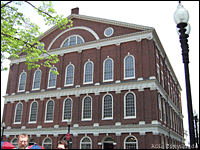
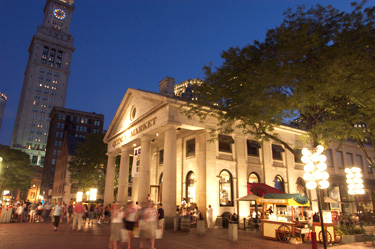
Faneuil
Hall
Before and after recent restoration
It was clear to me that the Boston
Massacre, which took place on March 5, 1770, when British troops
killed five colonists is a much-remembered, indeed, over-remembered
event. Even the word "massacre" is a bit of an exaggeration;
Webster's Collegiate Dictionary says the word denotes "wholesale
slaughter."
Still, there is no denying the ugliness of a militia firing into a crowd,
using as its rationale the traditional claim of trigger-happy police
- that the crowd was "unruly" as it undoubtedly was. John
Adams, who was defense lawyer for the British soldiers and
secured their acquittal, described the crowd as "a motley rabble
of saucy boys, Negroes and mulattos, Irish leagues and outlandish jack tarrs."
Adams could hardly have expressed more clearly that the race and class
of the victims, one of the dead, Crispus
Attucks, was a mulatto, made their lives less precious. This
was only one of many instances in which the Founding Fathers registered
their desire to keep revolutionary fervor under the control of more
prosperous classes.
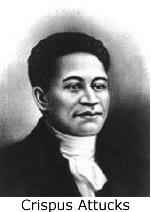
Ten thousand Bostonians, out of a total population of 16,000, marched
in the funeral procession for the victims of the Massacre. And the British,
hoping not to provoke more anger, pulled their troops out of Boston.
Undoubtedly, the incident helped build sentiment for independence.
Still, I wanted to discuss other massacres because it seemed to me that
concentrating attention on the Boston Massacre would be a painless exercise
in patriotic fervor. There is no surer way to obscure the deep divisions
of race and class in American history than by uniting us in support
of the American Revolution and all its symbols, like Paul
Revere's stark etching of the soldiers shooting into the crowd.
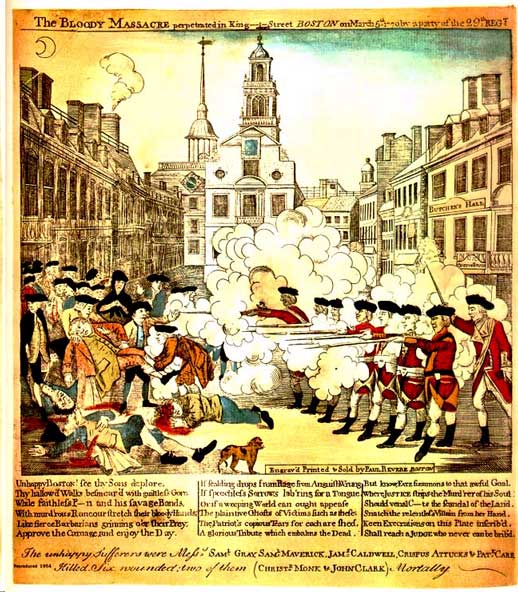
The
Boston 'Massacre'
Paur Revere's Gravure
I suggested to the people assembled at Faneuil Hall, the walls around
us crowded with portraits of the Founding Fathers and the nation's military
heroes, that there were other massacres, forgotten or dimly remembered,
that deserved to be recalled. These ignored episodes could tell us much
about racial hysteria and class struggle, about shameful moments in
our continental and overseas expansion, so that we can see ourselves
more clearly, more honestly.
Why, for instance, was there not a symposium on what we might call "the
Taino Massacre," perpetrated by Columbus and his fellow
conquistadors - which annihilated the native population of Hispaniola? Before they arrived, there were several million living on that island.
By 1550, perhaps only 50,000 were left on the island, which is now shared
by Haiti
and the Dominican Republic.
Or "the
Pequot Massacre" of 1636, when our Puritan ancestors,
well, I am stretching my ancestry a little, in an expedition led by Captain John
Mason, set fire to a village of Pequot
Indians on the Connecticut shore of Long Island Sound?
"Those that scaped the fire were slaine with the sword, some hewed
to peeces ... and very few escaped," wrote a contemporary, William
Bradford, in his History of Plymouth Plantation. And the Puritan
theologian Cotton
Mather wrote: "It was supposed that no less than 600 Pequot
souls were brought down to hell that day." Mather was an expert
on the destination of souls.
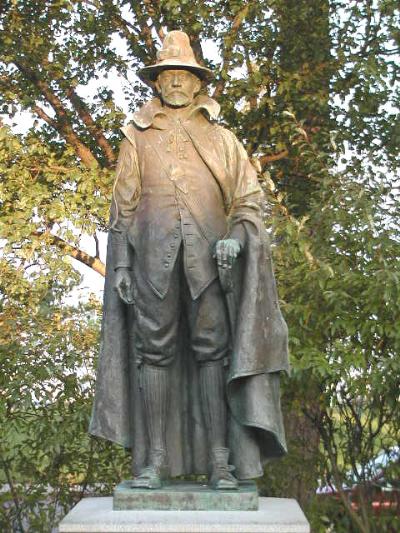
William
Bradford
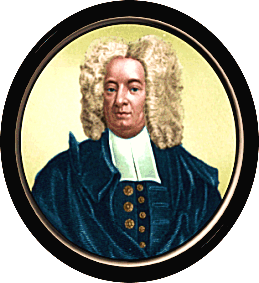
Cotton
Mather
The massacres
of Indians by the armies of the United States - in Colorado
in 1864, in Montana in 1870, in South Dakota in 1890, to cite just a
few - were massacres in the most literal sense: that is, wholesale
slaughter in each case of hundreds of unarmed men, women, and
children. The number of those events cannot be counted, and should by
that fact be a subject for intense scrutiny.
The results of such an investigation would be as sobering to young Americans
as the story of the Boston Massacre is inspiring. And sobriety about
our national sins, sorry to use Dr. Mather's terminology, might be very
instructive at a time when we need to consider what role we will play
in the world this next century.
What of the massacres of African Americans, whether by official acts
or by white mobs, with the collaboration of government officials? I
will cite just two of many.
In the first months of the nation's entrance into World War I, an article
called "The
Massacre of East St. Louis" appeared in the NAACP publication,
Crisis, written by W. E. B. Du Bois and Martha Gruening. In that poor
Illinois city, African Americans had been hired to replace whites, and
hysteria took hold. Job desperation was a common cause of mob violence,
as when whites attacked Chinese miners in Rock
Spring, Wyoming, in 1885, killing twenty-five.
The black section of East St. Louis became the object of attack by a
white mob, leaving 6,000 blacks homeless and perhaps 200 dead. Mangled
bodies were found floating in the Mississippi River. Josephine
Baker, the St. Louis-born entertainer who decided she could
not live in this country, said at the time, "The very idea of America
makes me shake and tremble and gives me nightmares."
Other
African Americans protested. In New York City, thousands marched silently
down Fifth Avenue to the roll of drums, with signs addressed to President
Woodrow Wilson: MR. PRESIDENT, WHY NOT MAKE AMERICA SAFE FOR DEMOCRACY?
In 1921, in Tulsa,
Oklahoma, planes dropped nitroglycerin on a thirty-six-block
black business district, destroying hundreds of businesses, more than
1,000 homes, twenty churches, a hospital, libraries, and schools. The
number of black people killed was estimated by some in the hundreds,
by others in the thousands. Bodies were put into mass graves, stuffed
into mine shafts, or thrown into the river.
Nor do our history books take much notice of workers killed by police
and militia. I thought I knew about many of these events, but I keep
learning about more. I did not know until recently about the Bay
View Massacre in Milwaukee, which took place May 5,1886, the
day after the Haymarket bombing in Chicago. On that day, striking steelworkers, marching toward
a mill in the Bay View section of Milwaukee, were intercepted by a squad
of militia, who fired point blank into the strikers, killing seven.
In 1897, there was a coal strike in Pennsylvania. Immigrant Austrians,
Hungarians, Italians, and Germans were brought in to break it. But the
strikebreakers themselves soon organized and went on strike. Marching
toward the Lattimer mine, they refused to disperse. The sheriff and
his deputies opened fire and killed nineteen of them. Most were shot
in the back.
When, the following year, the press set out to create a national excitement
over the mysterious sinking of the battleship Maine in Havana harbor,
a machinists' journal pointed to the Lattimer
Massacre, saying that the deaths of workers resulted in no
such uproar. It pointed out that "the carnival of carnage that
takes place every day, month, and year in the realm of industry, the
thousands of useful lives that are annually sacrificed to the Moloch
of greed ... brings forth no shout for vengeance and reparation."
Better known, but still absent from the mainstream history books, is
the Ludlow Massacre of 1914. Two companies of National Guardsmen, their pay underwritten
by the Rockefeller interests that owned the Colorado Fuel & Iron
Corporation, launched a military attack on the miners' tent colony,
where 1,000 men, women, and children lived. The Guardsmen poured machine-gun
fire into the tents, then burned them. Eleven children and two women
died in the conflagration.
One of the many strikes of the Depression years was against Republic
Steel in Chicago in 1937. Police began firing at a picket line
and continued firing as the workers fled, killing ten in what came to
be known as the Memorial
Day Massacre.
Even less likely to enter the history books are the atrocities the United
States commits overseas. High school and college texts usually deal
at length with the three-month Spanish-American
War, portraying the United States as liberating Cuba from Spain
and admiring Theodore Roosevelt's exploits with the "Rough Riders."
But they rarely pay important attention to the eight-year war to conquer
the Philippines, a bloody affair that in many ways resembled the war
in Vietnam. The United States killed hundreds of thousands of Filipinos
in the war, but U.S. casualties were under 5,000.
In 1906, an American military detachment attacked a village of Filipino
Moslems ("Moros") living in the hollow of a mountain in one
of the southern islands. Every one of 600 men, women, and children were
killed. This was the Moro
Massacre, which drew an angry response from Mark Twain and
other anti-imperialist Americans.
In his capacity as vice president of the Anti-Imperialist League, Twain
wrote: "We have pacified thousands of the islanders and buried
them, destroyed their fields, burned their villages, turned their widows
and orphans out-of-doors, furnished heartbreak by exile to dozens of
disagreeable patriots, and subjugated the remaining ten million by Benevolent
Assimilation."
Those of us who were of age during the Vietnam War remember the My
Lai Massacre of 1968, in which a company of American soldiers
poured automatic rifle fire into groups of unarmed villagers, killing
perhaps 500 people, many of them women and children. But when I spoke
last fall to a group of 100 high school honors students in history and
asked who knew about the My Lai Massacre, no one raised a hand.
My Lai was not a unique event. An Army colonel charged with covering
up the My
Lai incident told reporters: "Every unit of brigade size
has its My Lai hidden someplace."
And if the word "massacre" means indiscriminate mass slaughter
of innocent people, is it not reasonable to call the bombings of Hiroshima
and Nagasaki "massacres," as well as the fire-bombing of Tokyo
and the destruction of Dresden and other German cities?
In Ignazio Silone's novel Fontamara,
about peasants under Italian fascism, the resistance movement distributed
leaflets just giving out information that had been suppressed, and then
simply asking, "She fare?" "What shall we do?" "They
have killed Berardo Viola. What shall we do? They have taken away our
water. What shall we do? They violate our women in the name of the law.
What shall we do?"
When our government, our media, and our institutions of higher learning
select certain events for remembering and ignore others, we have the
responsibility to supply the missing information. Just to tell untold
truths has a powerful effect, for people with ordinary common sense
may then ask themselves and others, "What shall we do?". --
HOWARD ZINN is the author of "A People's History of the United
States" (Harper Perennial). His latest book is "The Zinn Reader:
Writings on Disobedience and Democracy" (Seven Stories Press).
NOTE OF INTEREST: Few, if any, references to any of the above massacres could
be found while Googling the word 'Massacres'. Almost all entries are
to massacres that occurred on foreign soil.